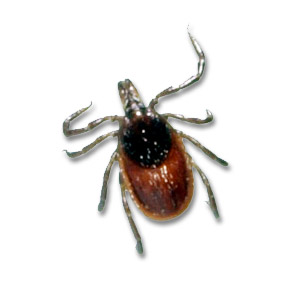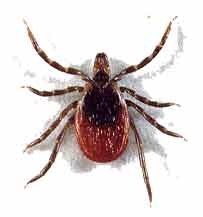Ticks usually live in woods or tall grasslands in various regions of the country. Tick bites happen usually from May to September, but it can change depending on the area and the year.
Ticks must feed for several hours before they can infect a person (or animal) with the bacteria causing Lyme disease (Borrelia burgdorferi), their bites are usually painless and often unnoticed. Lyme disease does not spread from person to person.
Skin rash (not necessarily around the bite area) especially one that looks like a "Bull's Eye" and that could develop as big as a dinner plate.
In some cases paralysis may occur. It usually starts in the feet and legs and gradually works its way up to the upper body, arms and head. This could develop from within a few hours to several days.
Blood tests can detect antibodies produced by the body to protect itself against the bacteria that cause Lyme disease. These tests show that exposure has occurred, but they do not show that people have active cases of the disease. A physician must do a medical examination and get a work history about job activities to diagnose Lyme disease.
TREATMENT
According to the Centre for Occupational Health and Safety: in any tick-related disease, you will need need antibiotics to prevent complications. Antibiotics are very efficient whatever the stage of the illness.
Without proper treatment various problems could occur and worsen. Cases of arthritis could lead to permanent disability and in rare cases serious changes in the nervous system may result in loss of feeling in the limbs, loss of memory, and extreme tiredness.
FIRST AID:
The B.C. Centre for Disease Control suggests to use tweezers to remove carefully the tick as close to the skin as possible (near the head and mouth), don't squash it as it might spread bacteria. Wash the affected area with soap and water and then apply disinfectant.
For updated case numbers, see the BCCDC Web site at www.bccdc.org.
AVOIDING TICKS
There is currently no effective vaccine licensed in Canada. Prevention is the key to prevent illness.
Here are some tips to protect yourself against tick and insect bites:
Walk on cleared trails wherever possible when walking in tall grass or woods.
Wear light coloured clothing, long sleeves and tuck your pants into your boots or socks.
Put insect repellent containing 5% Permethrin onto clothing and insect repellent containing DEET on all uncovered skin. Follow the instructions on the container.
Check clothing and scalp (even if covered) when leaving an area where ticks may live. When a tick is located, remove it immediately, you might find more than one tick.
Regularly check your pets especially if they go into tall grass and wooded areas.
TICKS' APPEARANCE:
Ticks range in size from 1 to 4 millimeters (around the size of a small ant). However, unlike insects, ticks have eight legs instead of six (they belong to the arachnids family).
Ticks don't have wings, therefore they hang onto small bushes or tall grass close to the ground and use passing animals or persons to move around and feed from their blood.



